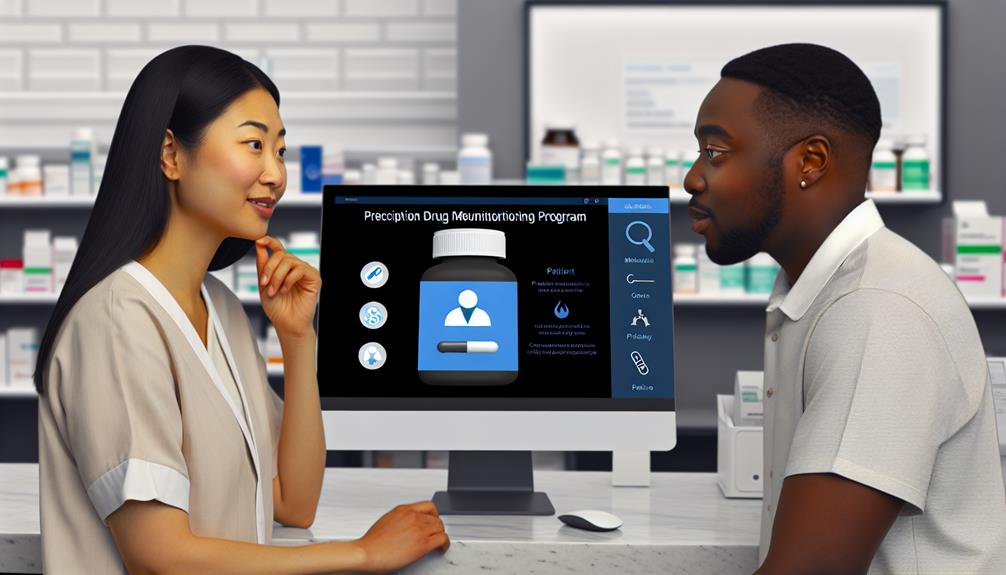Have you ever wondered how pharmacists contribute to the prevention of prescription drug abuse?
Imagine a scenario where a patient visits their local pharmacy to refill a prescription for a powerful painkiller. As the pharmacist, you have access to a prescription drug monitoring program (PDMP) that tracks the patient's medication history. This tool allows you to play a vital role in detecting potential abuse and ensuring patient safety.
But what exactly is the pharmacist's role in prescription drug monitoring programs?
Let's explore this topic further and discover the important responsibilities that pharmacists hold in monitoring and preventing prescription drug misuse.
Importance of Prescription Drug Monitoring Programs

Prescription drug monitoring programs play a vital role in safeguarding public health by closely monitoring the dispensing and use of controlled substances. These programs, often implemented at the state level, rely on collaboration with law enforcement agencies to effectively combat the opioid epidemic. By tracking the prescribing and dispensing patterns of controlled substances, these programs help identify potential cases of overprescribing or diversion, allowing for early intervention and prevention of abuse.
One of the key benefits of prescription drug monitoring programs is their ability to provide valuable data to law enforcement agencies. This data can be used to identify individuals who may be engaged in illegal activities, such as doctor shopping or prescription forgery. Through this collaboration, law enforcement can take appropriate action to hold these individuals accountable and prevent further harm.
Furthermore, prescription drug monitoring programs have a significant impact on the opioid epidemic. By tracking the dispensing of opioids and other controlled substances, these programs can identify patterns of abuse and misuse. This information can then be used to inform public health initiatives, such as targeted education and intervention programs, to address the root causes of the epidemic.
Role of Pharmacists in Monitoring Prescription Drugs
Pharmacists play a crucial role in actively monitoring and ensuring the safe use of prescription drugs. As frontline healthcare professionals, they're responsible for dispensing medications and educating patients on their appropriate use. When it comes to prescription drug monitoring, pharmacists have a unique position to identify potential risks and prevent any adverse reactions or drug interactions.
One of the key responsibilities of pharmacists in monitoring prescription drugs is to review and verify prescriptions for accuracy and appropriateness. They carefully evaluate the medication orders, checking for any potential contraindications or drug interactions that could pose harm to the patient. Pharmacists also play a vital role in counseling patients on the proper use of their medications, including dosage instructions and potential side effects. This ensures that patients understand how to take their medications safely and effectively.
In addition to their direct patient interactions, pharmacists also collaborate with healthcare providers and other healthcare professionals to optimize medication therapy. They participate in medication therapy management programs, where they review patient medication histories, identify potential drug-related problems, and make recommendations to improve treatment outcomes. Pharmacists also contribute to the surveillance and reporting of adverse drug events, helping to improve patient safety and quality of care.
Collaboration Between Pharmacists and Healthcare Providers

As frontline healthcare professionals responsible for dispensing medications and ensuring safe use, pharmacists actively collaborate with healthcare providers to optimize medication therapy and improve patient outcomes. Collaboration between pharmacists and healthcare providers is essential in providing comprehensive and patient-centered care.
Here are four ways in which pharmacists collaborate with healthcare providers:
- Medication Reviews: Pharmacists collaborate with healthcare providers to conduct medication reviews, ensuring that patients are taking the right medications at the right doses and avoiding any potential drug interactions or adverse effects. This collaboration helps to optimize medication therapy and improve patient safety.
- Medication Reconciliation: Pharmacists work closely with healthcare providers to ensure accurate medication reconciliation during care transitions, such as hospital admissions or transfers. By reviewing and reconciling medication lists, pharmacists help prevent medication errors and ensure continuity of care.
- Collaborative Drug Therapy Management (CDTM): Pharmacists and healthcare providers collaborate through CDTM programs, which enable pharmacists to initiate, modify, or monitor medication therapy under specific protocols. This collaboration allows for more timely and effective medication adjustments, enhancing patient outcomes.
- Patient Education: Pharmacists collaborate with healthcare providers to educate patients about their medications, including proper administration, potential side effects, and adherence strategies. This collaboration helps patients better understand their medications, leading to improved medication adherence and overall health outcomes.
Utilizing Prescription Drug Monitoring Programs to Prevent Abuse
Utilizing prescription drug monitoring programs is an effective strategy in preventing abuse and misuse of medications. These programs play a vital role in reducing opioid misuse and preventing addiction.
Pharmacists, as key healthcare professionals, have a crucial role in utilizing and leveraging these programs to protect patients and the community.
Prescription drug monitoring programs (PDMPs) are electronic databases that collect and track prescription data for controlled substances. Pharmacists can access these databases to review a patient's prescription history, including the medications they've been prescribed and dispensed. By analyzing this data, pharmacists can identify potential patterns of abuse, doctor shopping, or excessive use of medications.
Through PDMPs, pharmacists can proactively intervene in cases where there may be signs of abuse or misuse. Pharmacists can provide counseling, education, and support to patients who may be at risk of developing addiction. They can also collaborate with healthcare providers to develop personalized treatment plans that prioritize patient safety and promote responsible medication use.
Furthermore, pharmacists can use PDMPs to identify and report suspicious prescribing and dispensing practices. By sharing this information with relevant authorities, pharmacists contribute to the prevention of diversion and illicit drug trafficking, ultimately safeguarding the community.
Enhancing Patient Safety Through Pharmacist Involvement

By actively engaging in prescription drug monitoring programs, pharmacists play a crucial role in enhancing patient safety and preventing medication misuse. Through their involvement, pharmacists contribute to a comprehensive approach to patient care that goes beyond dispensing medications.
Here are four ways in which pharmacists enhance patient safety:
- Patient education: Pharmacists have the knowledge and expertise to educate patients about their medications, including proper usage, potential side effects, and the importance of adherence. By providing clear and concise information, pharmacists empower patients to make informed decisions about their healthcare.
- Technology integration: Pharmacists utilize advanced technology systems to access prescription drug monitoring program databases. These systems help pharmacists identify potential drug interactions, duplications, or misuse, allowing for timely interventions and improved patient safety.
- Medication reconciliation: Pharmacists play a vital role in ensuring accurate medication reconciliation during transitions of care, such as hospital discharge or changes in healthcare providers. By reviewing patients' medication histories and collaborating with other healthcare professionals, pharmacists help prevent medication errors and adverse drug events.
- Adverse event reporting: Pharmacists are trained to recognize and report adverse events associated with medications. By promptly reporting such events, pharmacists contribute to the ongoing monitoring and evaluation of medication safety, ultimately enhancing patient care.








